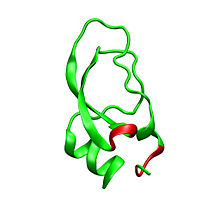Dendrotoxins


Dendrotoxins are a group of proteins and neurotoxins that are produced by various Mamba species ( Dendroaspis sp. ).
properties
Dendrotoxins are snake poisons that bind to voltage-gated potassium channels in nerve cells . They are used by the mambas to paralyze their prey. They are between 57 and 60 amino acids long and have three disulfide bridges and a molecular weight of around 7 kilodaltons . Dendrotoxins have a typical structural motif near the N terminus, a lysine , followed by a hydrophobic amino acid . This structural motif can also be found in unrelated invertebrate toxins with the same binding target, which was interpreted as convergent evolution . The dendrotoxins α-dendrotoxin and toxin I bind to the potassium channels Kv1.1, Kv1.2 and Kv1.6, while toxin K mainly binds Kv1.1.
Dendrotoxins have structural similarities to protease inhibitors of the Kunitz type, such as aprotinin , without having the protease-inhibiting properties. The venom of the wasps Eumenes pomiformis , Anoplius samariensis and Rhynchium brunneum contain toxins related to dendrotoxin, EpDTX and As-fr-19.
Applications
Dendrotoxins are used for indirect molecular labeling of voltage-gated potassium channels.
Web links
Individual evidence
- ^ RJ McCleary, RM Kini: Non-enzymatic proteins from snake venoms: a gold mine of pharmacological tools and drug leads. In: Toxicon: official journal of the International Society on Toxinology. Volume 62, February 2013, pp. 56-74, doi : 10.1016 / j.toxicon.2012.09.008 , PMID 23058997 .
- ↑ a b A. L. Harvey: Recent studies on dendrotoxins and potassium ion channels. In: General pharmacology. Volume 28, Number 1, January 1997, pp. 7-12, PMID 9112070 .
- ^ A b S. Gasparini, JM Danse, A. Lecoq, S. Pinkasfeld, S. Zinn-Justin, LC Young, CC de Medeiros, EG Rowan, AL Harvey, A. Ménez: Delineation of the functional site of alpha-dendrotoxin . The functional topographies of dendrotoxins are different but share a conserved core with those of other Kv1 potassium channel-blocking toxins. In: The Journal of biological chemistry. Volume 273, Number 39, September 1998, pp. 25393-25403, PMID 9738007 .
- ^ AL Harvey, B. Robertson: Dendrotoxins: structure-activity relationships and effects on potassium ion channels. In: Current medicinal chemistry. Volume 11, Number 23, December 2004, pp. 3065-3072, PMID 15579000 .
- ↑ SH Lee, JH Baek, KA Yoon: Differential Properties of Venom Peptides and Proteins in Solitary vs. Social Hunting Wasps. In: Toxins. Volume 8, number 2, January 2016, p. 32, doi : 10.3390 / toxins8020032 , PMID 26805885 , PMC 4773785 (free full text).
- ^ AL Harvey: Twenty years of dendrotoxins. In: Toxicon: official journal of the International Society on Toxinology. Volume 39, Number 1, January 2001, pp. 15-26, PMID 10936620 .